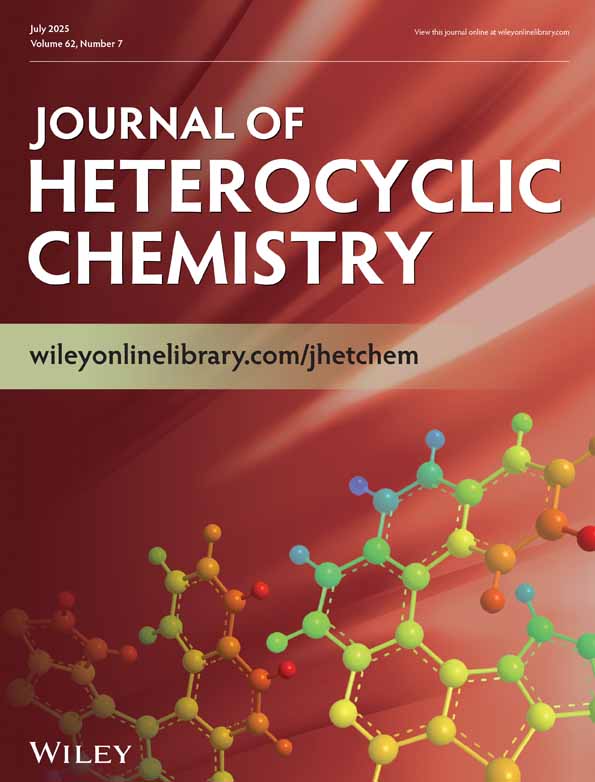A new synthesis of aryl hetaryl ketones via SRN1 reactions of halogenated heterocycles with potassiophenylacetonitrile followed by phase-transfer catalyzed decyanation†
Christine K. F. Hermann
Department of Chemistry, Virginia Polytechnic Institute and State University, Blacksburg, VA 24061
Search for more papers by this authorYesh P. Sachdeva
Department of Chemistry, Virginia Polytechnic Institute and State University, Blacksburg, VA 24061
Search for more papers by this authorJames F. Wolfe
Department of Chemistry, Virginia Polytechnic Institute and State University, Blacksburg, VA 24061
Search for more papers by this authorChristine K. F. Hermann
Department of Chemistry, Virginia Polytechnic Institute and State University, Blacksburg, VA 24061
Search for more papers by this authorYesh P. Sachdeva
Department of Chemistry, Virginia Polytechnic Institute and State University, Blacksburg, VA 24061
Search for more papers by this authorJames F. Wolfe
Department of Chemistry, Virginia Polytechnic Institute and State University, Blacksburg, VA 24061
Search for more papers by this authorPresented at the 35th Southeast Regional ACS Meeting, Charlotte, NC, Nov 9–11, 1983. Paper No. 463; [c] Abstracted in part from the Ph.D. dissertation of C. K. F. Hermann, Virginia Polytechnic Institute and State University, May, 1984
Abstract
Reaction of halogenated pyridines, quinolines, pyrimidines, and pyrazines with potassiophenylacetonitrile (5) in liquid ammonia under near-uv irradiation affords secondary nitriles, which then undergo oxidative decyanation under phase-transfer catalytic conditions to afford aryl hetaryl ketones in excellent yields.
References and Notes
- 2 D. R. Carver, T. D. Greenwood, J. S. Hubbard, A. P. Komin, Y. P. Sachdeva, and J. F. Wolfe, J. Org. Chem., 48, 1180 (1983).
- 3a M. Jawdosiuk, M. Ludwikow, and B. Bednarska, Pol. J. Chem., 53, 809 (1979); b M. Makosza, M. Jagusztyn-Grochowska, and M. Ludwikow, Tetrahedron, 30, 3723 (1974); c For an excellent review of phase-transfer reactions see W. E. Keller, “ Compendium of Phase-Transfer Reactions and Related Synthetic Methods. Comprehensive Register of Syntheses by Phase-Transfer Catalysis, Ion-Pair Extraction and by Reactions of Quarternary Ammonium Salts in a Homogeneous Phase of Non-aqueous Solvents,” Fluka AG, CH-9470 Buchs, Switzerland, 1979.
- 4 The most commonly encountered methods for the syntheses of ketones of type 7 involve: [a] Reactions of metalated heterocycles with aryl nitriles, esters and anhydrides: J. P. Wibaut, and L. G. Heeringa, Rec. Trav. Chim., 74, 1003 (1955) W. L. Mendelson, U. S. Patent 3,840,547, Oct. 8, 1974; Chem. Abstr., 82, 31264m (1975) W. E. Parham, and R. M. Piccirilli, J. Org. Chem., 42, 257 (1977); b Reactions of heteroaromatic nitriles with aryl Grignard reagents: E. Frank, J. Gearien, and C. Pokorny, J. Med. Chem., 14, 551 (1971); S. C. Shaw, B. Kumar, and H. C. Shaw, J. Ind. Chem., 15, 916 (1978); c Acylation of benzene derivatives with hetaryl carboxylic acid chlorides: F. J. Villani, M. S. King, and D. Papa, J. Org. Chem., 17, 249 (1952); R. C. Fuson and J. J. Miller, J. Am. Chem. Soc., 79, 3477 (1957); d Decarboxylative acylation of quinaldinic acid: B. R. Brown and D. L. Hammick, J. Chem. Soc., 173 (1949) e The use of Reissert compounds: H. V. Kamath, K. S. Nargund and S. N. Kulkarni, Indian J. Chem., 16b, 903 (1978); f Oxidation of benzylheterocycles: P. C. Teague, J. Am. Chem. Soc., 69, 714 (1947). K. E. Crook and S. M. McElvain, J. Am. Chem. Soc., 52, 4006 (1930).
- 5a For a recent description of several such methods see: R. W. Freerksen, S. J. Selikson, R. R. Wroble, K. S. Kyler, and D. S. Watt, J. Org. Chem., 48, 4087 (1983) and references cited therein; b S. S. Kulp and M. J. McGee, 48, 4097 (1983).
- 6 For what appears to be the only previous report of PTC conversion of secondary nitriles to ketones see: A. Donetti, O. Bonairdi, and A. Ezhaya, Synthesis, 1009 (1980).
- 7 M. P. Moon, A. P. Komin, and J. F. Wolfe, and G. F. Morris, J. Org. Chem., 48, 2392 (1983).
- 8 D. R. Carver, A. P. Komin, J. S. Hubbard, and J. F. Wolfe, J. Org. Chem., 46, 294 (1981).
- 9a Alkali metal-promoted reactions of carbanion 5 with diethyl phenyl phosphate and phenyltrimethylammonium iodide have been reported to give low yields of products originating from coupling of phenyl radicals at the α-position of 5: J. F. Bunnett and B. F. Gloor, J. Org. Chem., 38, 4156 (1973) b Photostimulated reaction of 5 with 2,4-dichloropyrimidine results in exclusive α-coupling of 5 with the 2-chloro-4-pyrimidinyl radical: see ref [2].
- 10 Attempts to effect direct formation of ketone 7b from 4b and 5 by exposing the unneutralized liquid ammonia reaction mixture to atmospheric oxygen after photostimulation proved to be less satisfactory than this procedure.
- 11 D. D. Perrin, W. L. F. Armarego and D. R. Perrin, “ Purification of Laboratory Chemicals”, Pergamon Press, Oxford, 1966.
- 12 W. C. Still, M. Kahn, and A. Mitra, J. Org. Chem., 43, 2923 (1978).
- 13 J. F. Wolfe and D. R. Carver, Org. Prep. Proced. Int., 10, 225 (1978).
- 14 L. Panizzon, Helv. Chim. Acta., 27, 1748 (1944); bp 150–155° (0.5 mm Hg); mp 89°.
- 15 Y. Mizuno, K. Adachi, and K. Ikeda, Pharm. Bull., 2, 225 (1954); bp 207–211° (2 mm Hg), mp 92–93°.
- 16 J. W. Cusic and H. W. Sause, U. S. Patent 3,225,054 Dec. 21, 1965; Chem. Abstr., 64, 6625fg (1966) bp 133–136° (0.35 mm Hg), mp 76–77°.
- 17 H. S. Mosher and J. E. Tessieri, J. Am. Chem. Soc., 73, 4925 (1951); bp 155–157° (2.0 mm Hg), mp 63–65°.
- 18 G. Suangawa, et al., Japan Patent 630 ('54); Chem. Abstr., 49, 11028g (1955); bp 170° (2 mm Hg).
- 19 C. E. Malen, B. H. Danree and X. B. L. Pascaud, J. Med. Chem., 14, 244, (1971); bp 50–54° (0.5 mm Hg) for compound 6h and bp 48–52° (0.1 mm Hg) for compound 6i.




